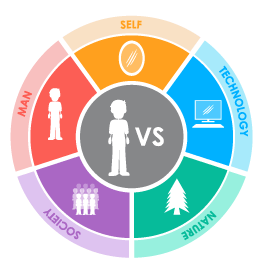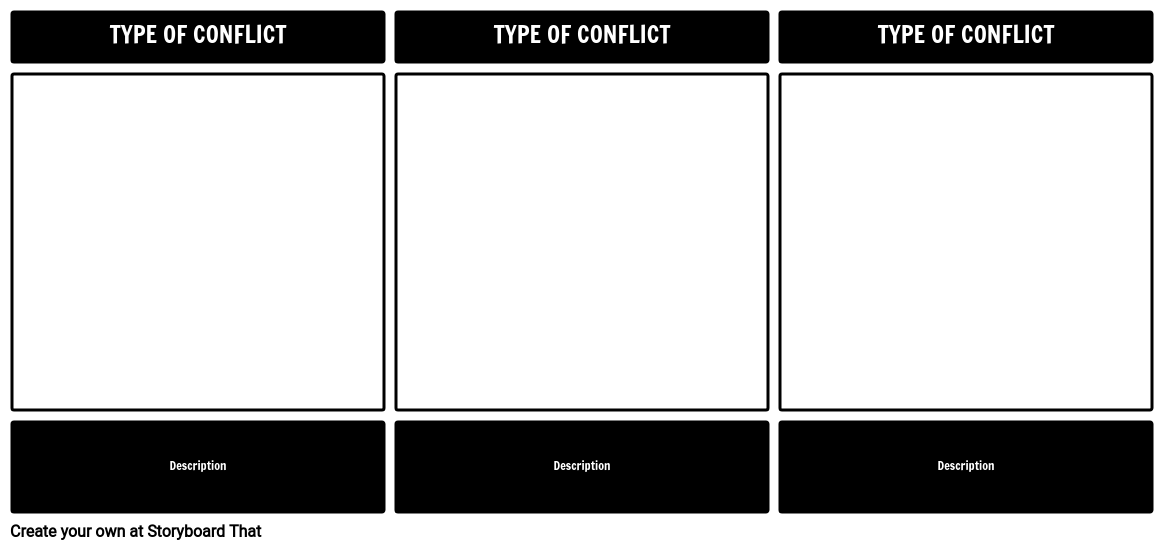Activity Overview
Literary conflicts are another major element often taught during ELA units. Building on prior knowledge to achieve mastery level with our students is important. An excellent way to focus on the various types of literary conflict is by creating a storyboard. As students read Bud, Not Buddy, have them choose an example of each literary conflict and depict it using the storyboard creator!
Examples of Literary Conflict in Bud, Not Buddy
MAN vs. SOCIETY
One conflict is between Bud and the orphanage: Bud was placed in an unfit foster home.
MAN vs. MAN
Another conflict is between Bud and the Amoses: Todd physically attacked Bud while he was sleeping, and Mr. and Mrs. Amos locked Bud in the shed overnight.
MAN vs. MAN
The last conflict is between Bud and Mr. Calloway. Bud confronts Mr. Calloway and identifies him as his father, but Mr. Calloway wants nothing to do with Bud and barely acknowledges him.
Template and Class Instructions
(These instructions are completely customizable. After clicking "Copy Activity", update the instructions on the Edit Tab of the assignment.)
Student Instructions
Create a storyboard that shows at least three forms of literary conflict in Bud, Not Buddy.
- Identify conflicts in Bud, Not Buddy.
- Categorize each conflict as Character vs. Character, Character vs. Self, Character vs. Society, Character vs. Nature, or Character vs. Technology.
- Illustrate conflicts in the cells, using characters from the story.
- Write a short description of the conflict below the cell.
Lesson Plan Reference
Rubric
(You can also create your own on Quick Rubric.)
| Proficient | Emerging | Beginning | Try Again | |
|---|---|---|---|---|
| Conflict Identification | Student identifies correct major conflicts and uses strong, clear textual evidence to support choice. | Student identifies correct major conflict and uses few or unclear details to support their choice. | Student identifies incorrect major conflict, and uses some details from the text to support their choice. | Student does not attempt to identify major conflict or identifies incorrect major conflict with no explanation. |
| Understanding Outcome | Student clearly shows the outcome of the conflict and its effects on the protagonist with evidence from the text. | Student shows the outcome of the conflict and its effect on the protagonist, but some evidence is unclear. | Student shows the outcome of the conflict, but does not examine its effect on the protagonist and uses some vague textual evidence. | Student does not clearly show the outcome of the conflict or use textual evidence. |
| Character | Storyboard includes all required characters and clearly names them. Goes above and beyond by adding additional details. | Storyboard includes all required characters and clearly names them. | Storyboard includes protagonist and antagonist but leaves out other required characters. | Storyboard does not include the names of required characters. |
| Storyboard | Student clearly shows effort to convey the setting the scene of the book | Student attempts to convey setting and scene of the book, but lacks some clarity. | Student does not clearly convey the setting and scene. | Student makes little or no attempt to convey the setting or scene. |
| Spelling and Grammar | Student uses exemplary spelling and grammar. There are no errors. | Student makes a minor error in spelling and grammar. | Student makes several minor errors in spelling and grammar. | Student makes many errors in spelling and grammar; little attempt at spellchecking. |
How To Introduce Literary Conflict To Special Education Students
Provide Simple Introductions
Teachers should find out the simplest way to provide the definition of the concept. They should use simple language and relate to real-life scenarios that students take an interest in.
Give Visual Aids
Teachers can use visual aids like pictures, charts, or graphic organizers to illustrate the various sorts of conflict (such as person vs person, person vs self, and person vs society). For students in special education, visuals can help make abstract ideas more apparent and approachable.
Encourage Discussion
Teachers can provide a safe and comfortable environment for students where they are not scared or embarrassed to ask questions and can easily carry out discussions with their class fellows.
Organize Activities
Organize multi-sensory activities around the concept where each student can focus on what they can do best and no one feels left out. This way they will be able to get a better understanding of the concept. Activities such as role-playing, drawing, and writing work the best.
Frequently Asked Questions About Bud, Not Buddy Literary Conflict
How is Bud's journey in the story impacted by the conflict of character vs. self?
The internal struggle between self and others has a big influence on Bud's path. Bud struggles with finding his own identity since he faced abandonment in the past. He is motivated by this tension to look for solutions and to discover his father.
How are the events of "Bud, Not Buddy" influenced by the struggle between the individual and society?
As Bud navigates a racially separated world during the Great Depression, the tension of character vs. Society develops throughout the entire narrative. He deals with prejudice and discrimination, which affects his interaction with and perspective of other people and the decisions he makes.
What role do the tensions in "Bud, Not Buddy" have in the themes and messages of the story?
The story's tensions support the themes of resiliency, family, and identity. Bud's quest to locate his father while navigating the difficulties of the Great Depression demonstrates his tenacity and fortitude. The disputes also provided insight into the significance of belonging and the effect that bias in society has on people.
What kind of character development takes place in "Bud, Not Buddy" as issues are resolved?
In order for Bud to grow as a person, disputes should be resolved. Each battle he encounters advances his development and broadens his perspective on the world. He develops resilience and shapes his identity as a result of overcoming these difficulties.
More Storyboard That Activities
Bud, Not Buddy
© 2024 - Clever Prototypes, LLC - All rights reserved.
StoryboardThat is a trademark of Clever Prototypes, LLC, and Registered in U.S. Patent and Trademark Office











